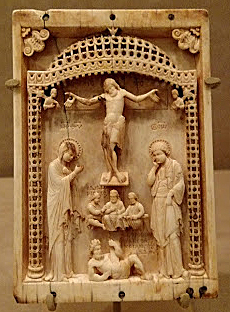
The Crucifixion
Mid-10th century
Ivory
Metropolitan Museum (17.190.44)
Jesus is presented as in many Romanesque Crucifixions, in a skirt, with the head bent as if in death, and the arms describing slight angles.
Mary and John flank the crucifix, identified by the Greek inscriptions above their heads. Mary points the viewer's regard toward her son, and John's hand clasps his cheek, a gesture supposed to represent contemplation. Both gestures thus guide the viewer's response.
At the bottom, the Greek inscription seems to indicate that the streams of blood from the cross are "piercing Hades." This idea is found in a 6th-century hymn by Romanos the Melodist:
Three crosses Pilate fixed on Golgotha
two for the thieves and one for the Giver of life,
whom Hell saw and said to those below,
"My ministers and powers, who has fixed a nail in my heart?
A wooden lance has suddenly pierced me and I am being torn apart.
My insides are in pain, my belly in agony,
my senses make my spirit tremble,
and I am compelled to disgorge Adam and Adam's race.
Given me by a Tree, a Tree is bringing them again to Paradise.
— Quoted in Daly, Apocalyptic Thought, 223
In other words Hell, where Adam and his race have been imprisoned since the Fall, is compelled to "disgorge" mankind from its "belly" because of the sacrifice by which Jesus suffered the piercing of the nails and the "wooden lance." The lance can be interpreted as the spear that pierced Jesus' side or as a metaphor for the cross itself. The ivory shown here opts for that second interpretation.
Read more about The Crucifixion.
Photographed at the museum by Richard Stracke, shared under Attribution-NonCommercial-ShareAlike license.